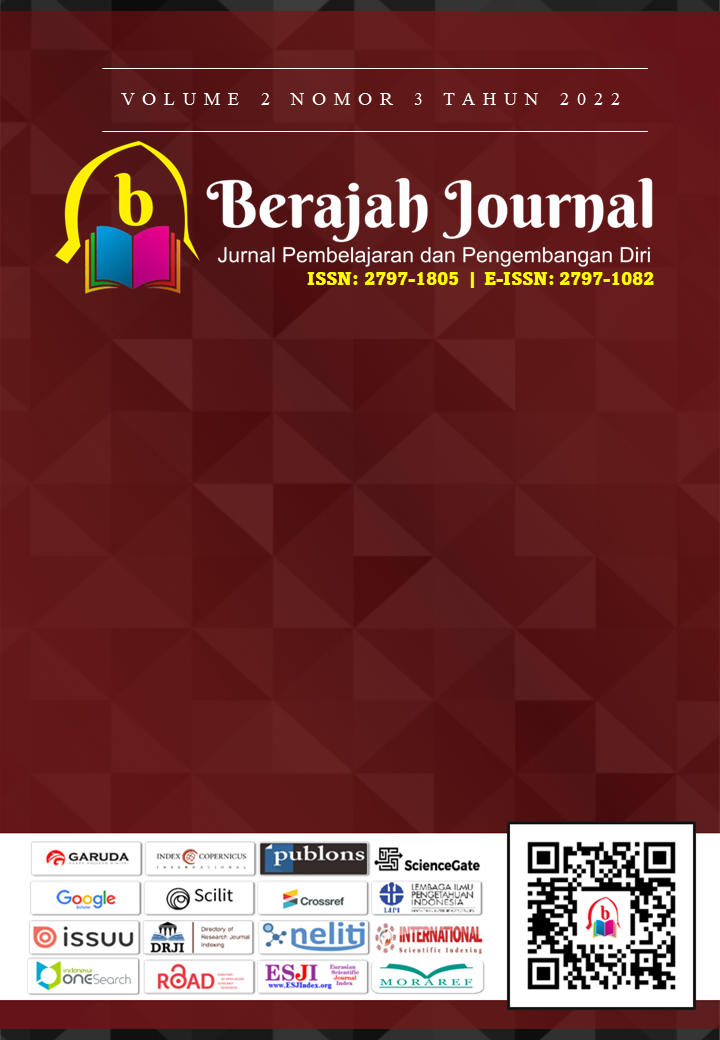PENGARUH PARENT ATTACHMENT TERHADAP SELF-ESTEEM REMAJA YANG ORANGTUANYA BERCERAI
DOI:
https://doi.org/10.47353/bj.v2i3.141Keywords:
parent attachment, self-esteem, remaja, orangtua berceraiAbstract
Penelitian ini bertujuan untuk mengetahui apakah terdapat pengaruh parent attachment terhadap self-esteem remaja yang orangtuanya yang bercerai. Parent attachment merupakan salah satu faktor yang dapat mempengaruhi self-esteem remaja. Penelitian dilakukan pada remaja berusia 14 – 21 tahun yang orangtuanya bercerai dengan jumlah subjek sebanyak 191 partisipan, yang terdiri atas 170 remaja perempuan dan 21 remaja laki-laki. Alat pengumpul data berupa kuesioner online dengan menggunakan skala Inventory of Parent and Peer Attachment Revised Version (IPPA-R) dan skala Rosenberg Self-esteem Scale (RSES). Analisis data dilakukan dengan menggunakan teknik analisis regresi linear sederhana, dengan bantuan program IBM Statistic 22.0 for Windows. Dari hasil analisis data penelitian diperoleh nilai signifikansi regresi parent attachment terhadap self-esteem remaja yang orangtuanya bercerai sebesar 0,000 (p = 0,000 < 0,05) yang artinya hipotesis kerja dapat diterima yaitu terdapat pengaruh parent attachment terhadap self-esteem remaja yang orangtua yang bercerai. Nilai koefisien regresi antara parent attachment dan self-esteem bernilai positif yakni sebesar 0,200 yang artinya semakin tinggi parent attachment maka akan semakin tinggi juga self-esteem remaja yang orangtuanya bercerai.
Downloads
References
Armsden, G. C., & Greenberg, M. T. (2009). Inventory of parent and peer attachment (IPPA). Seattle: University of Washington., August.
Astuti, R. D. N., & Wulandari, P. Y. (2018). Hubungan Antara Kelekatan Pada Orangtua Dan Self-Esteem Pada Remaja Dengan Status Middle-Child Born. Jurnal Psikologi Pendidikan Dan Perkembangan, 7, 59–65.
Azwar, S. (2007). Metode Penelitian. Pustaka Belajar.
Azwar, S. (2019). Penyusunan Skala Psikologi (2nd ed.). Pustaka Belajar.
Blascovich, J., & Tomaka, J. (1991). Measures of Self-Esteem. In Measures of Personality and Social Psychological Attitudes (Third Revi). Academic Press, Inc. https://doi.org/10.1016/b978-0-12-590241-0.50008-3
Bowlby, J. (1982). Attachment and Loss: Retrospect and Prospect. American Journal of Orthopsychiatry, 52(4), 664–678.
Coopersmith, S. (1967). The antecedents of self-esteem. W. H. Freeman and Company.
Dalifa, P. A. (2021). Hubungan antara Parent Attachment dengan Self Esteem pada Mahasiswa di Sumatera Barat. Jurnal Pendidikan Tambusai, 5(2), 3621–3626. https://jptam.org/index.php/jptam/article/view/1436
Diani Fathonah, Heris Hendriana, T. R. (2020). Gambaran Self Esteem Siswa Dari Keluarga Broken Home Di Sman 1 Ciwidey. Recherche En Soins Infirmiers, 3(4), 26–30. https://www.journal.ikipsiliwangi.ac.id/index.php/fokus/article/view/5788
Feldman, S. S., & Elliott, G. R. (1990). At the threshold: The developing adolescent. In S Shirley Feldman & G. R. Elliott (Eds.), At the threshold: The developing adolescent. Harvard University Press.
Gecas, V. (1982). The Self-concept. Annual Review of Sociology, 8, 1–33.
Goldberg, S., Muir, R., & Kerr, J. (2000). Book Review: Attachment theory: Social, developmental, and clinical perspectives. In International Journal of Behavioral Development (Vol. 21, Issue 4). https://doi.org/10.1177/016502549702100414
Hadori, R., Hastuti, D., & Puspitawati, H. (2020). Self-Esteem Remaja pada Keluarga Utuh dan Tunggal: Kaitannya dengan Komunikasi dan Kelekatan Orang Tua-Remaja. Jurnal Ilmu Keluarga Dan Konsumen, 13(1), 49–60.
Hurlock, E. B. (2003). Psikologi Perkembangan (5th ed.). Erlangga.
Indriani, D., Haslan, M. M., & Zubair, M. (2018). Dampak Perceraian Orang Tua terhadap Motivasi Belajar Anak. Jurnal Pendidikan Sosial Keberagaman, 5(1), 33–44. https://doi.org/10.29303/juridiksiam.v5i1.74
Laumi, & Adiyanti, M. G. (2013). Attachment of Late Adolescent to Mother, Father, and Peer, with Family Structure as Moderating Variable and their Relationships with Self-esteem. Jurnal Psikologi UGM, 39(2), 129–142. https://doi.org/10.22146/jpsi.6981
McIntosh, J., McIntosh, J., Gridley, H., Gridley, H., Burke, S., & Burke, S. (2009). Parenting after Separation: A Position Statement prepared for The Australian Psychological Society. The Australian Psychological Society, 497(July).
Mruk, C. J. (2006). Self-Esteem research, theory, and practice: Toward a positive psychology of self-esteem, 3rd ed. In Self-Esteem research, theory, and practice: Toward a positive psychology of self-esteem, 3rd ed. Springer Publishing Co.
Oswalt, A. (2010). Factors influencing the development of self-esteem. https://www.mentalhelp.net/self-esteem/factors-influencing-development/
Pallant, J. (2007). SPSS survival manual—A step by step guide to data analysis using SPSS for windows (3rd ed.). Open University Press.
Pallant, J. (2016). SPSS Survival Manual: A Step By Step Guide to Data Analysis Using SPSS Program (6th ed.). McGraw-Hill Education.
Parkes, C. M., & Prigerson, H. G. (2021). Attachment and loss. In Bereavement. Basic Books. https://doi.org/10.4324/9781315829753-13
Rosenberg, M. (1965). Society and the Adolescent Self-Image. NJ: Princeton University Press.
Santrock, J. W. (2002). Life-span development (Ed.8). McGraw-Hill Higher Education.
Santrock, J. W. (2018). A Tropical Approach to: LIFE-SPAN (Ninth Edition).
Soetjiningsih. (2014). Tumbuh Kembang Anak. Penerbit Buku Kedokteran EGC.
Downloads
Published
How to Cite
Issue
Section
License
Copyright (c) 2022 Salma Idzni Meisyah, Ika Yuniar Cahyanti

This work is licensed under a Creative Commons Attribution 4.0 International License.




















